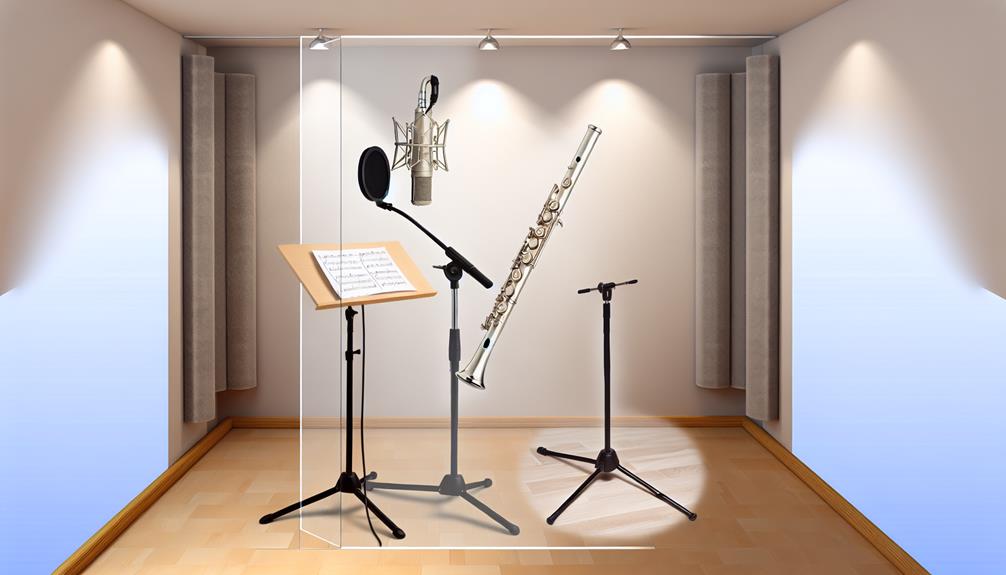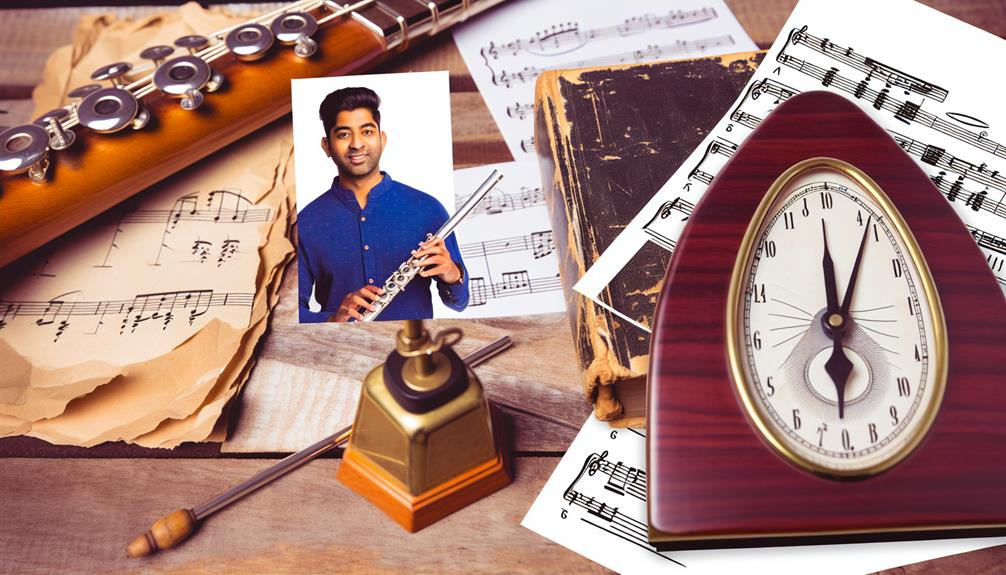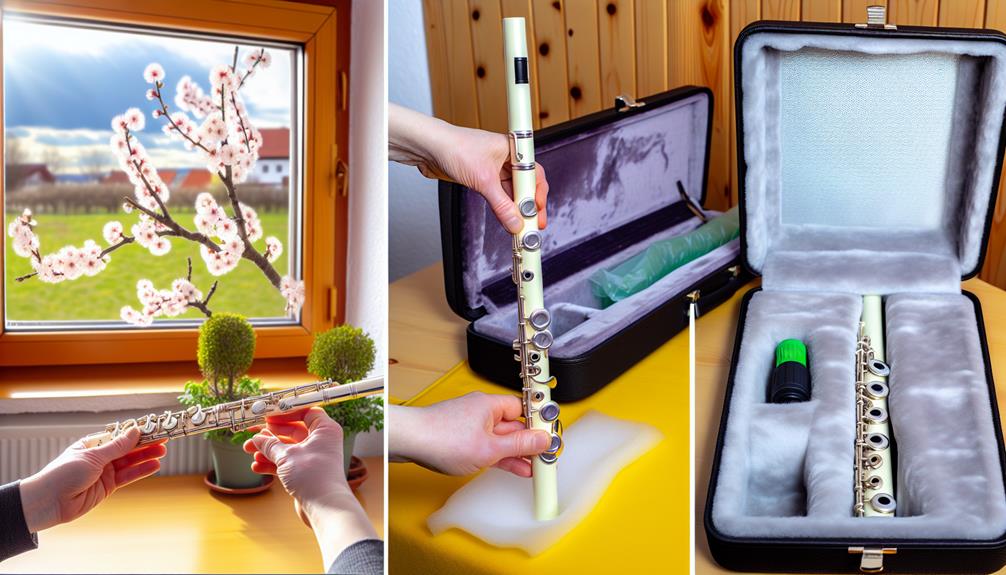Exploring the realm of flute playing proficiency involves a structured approach encompassing various exercises that target specific aspects of musical development. From honing breath control to mastering intricate finger agility drills, each exercise serves as a building block towards achieving a higher level of artistry and technical finesse. But what truly sets apart the top 10 exercises that can transform your flute playing from ordinary to extraordinary? Understanding the nuances of these exercises and their cumulative impact on your musical journey might just be the key to unlocking your full potential as a flutist.
Key Takeaways
- Practice breathing exercises to enhance control, develop lung capacity, and improve sound quality.
- Focus on long tone practice to refine technique, achieve resonant sound, and strengthen breath support.
- Work on scales, arpeggios, and finger agility drills to enhance fluency, dexterity, and finger flexibility.
- Include articulation exercises to elevate musical expression, technical abilities, and emotional conveyance through the flute.
- Dedicate time to dynamics, phrasing, and intonation practice for a well-rounded improvement in tone quality and musicality.
Breathing Exercises
To enhance your flute playing skills, incorporating specific breathing exercises into your practice routine is fundamental. Developing lung capacity and mastering diaphragm control are essential components for any flutist aiming to improve their playing technique. Proper breathing techniques not only enhance the quality of your sound but also contribute to better phrasing, dynamics, and overall musicality.
One effective breathing exercise to increase lung capacity involves taking deep breaths, filling your lungs to their maximum capacity, and then slowly releasing the air while maintaining control. Practice inhaling for a count of four, holding for a count of four, and exhaling for a count of eight to strengthen your respiratory muscles and expand your lung capacity over time.
Furthermore, focusing on diaphragm control is crucial for producing a consistent and steady airflow while playing the flute. Engage your diaphragm by practicing breathing exercises that involve pushing out your abdomen as you inhale deeply, allowing the diaphragm to descend and air to fill your lungs from the bottom up. This technique will help you avoid shallow breathing and ensure a more stable air support system for playing challenging passages with ease.
Long Tone Practice
Mastering long tone practice is a cornerstone of refining your flute playing technique and achieving a rich, resonant sound quality. Long tone exercises involve holding a single note for an extended period, focusing on producing a steady, consistent sound from the beginning to the end. The benefits of incorporating long tone practice into your daily routine are immense. Not only does it help improve your tone quality by enhancing control and stability, but it also aids in developing your breath support and embouchure strength.
Regularly practicing long tones can lead to significant improvements in your overall tone production. By sustaining a single note, you can focus on nuances such as dynamics, vibrato, and intonation, thereby honing your ability to express yourself musically. Moreover, long tone exercises provide an excellent opportunity to work on your breathing technique, ensuring that you have the necessary air support to produce a full, resonant sound.
To maximize the benefits of long tone practice, consider incorporating variations such as crescendos, decrescendos, and dynamic shifts into your routine. Experiment with different articulations and explore the full range of your flute to unlock its true potential. Remember, consistency is key; by dedicating time each day to long tone exercises, you will witness remarkable improvements in your tone quality and overall flute playing prowess.
Scales and Arpeggios
Regularly incorporating scales and arpeggios into your practice routine is essential for enhancing your fluency and dexterity on the flute. These fundamental exercises not only help in improving technique but also play a crucial role in the development of musicality. Scales are the building blocks of music, and mastering them will pave the way for greater proficiency in your flute playing.
Practicing scales in different keys will familiarize you with various tonalities, enabling you to navigate through different pieces more effortlessly. Arpeggios, on the other hand, focus on the individual notes within chords, helping you understand the harmonic structure of the music you are playing. By incorporating both scales and arpeggios into your daily practice, you will notice significant improvements in your overall playing ability.
When practicing scales and arpeggios, pay attention to your tone quality, intonation, and articulation. Aim for a clear and consistent sound throughout the entire range of the flute. Focus on maintaining a steady tempo and evenness in your articulation to build a strong foundation for more complex musical passages.
Finger Agility Drills
Enhancing your finger agility through targeted drills is a key component in elevating your proficiency and versatility as a flute player. Finger flexibility is crucial for executing rapid passages with precision and ease. One effective exercise to enhance finger flexibility is practicing scales in various patterns, such as thirds or chromatic sequences, to challenge your fingers to move quickly and accurately across the keys.
Speed drills are another essential aspect of improving finger agility. Set a metronome to a comfortable pace and gradually increase the speed as you become more comfortable with the exercise. Start with simple patterns and scales, focusing on clean articulation and evenness in your playing. As you progress, incorporate more complex patterns and intervals to further challenge your fingers.
Consistency is key when working on finger agility drills. Dedicate a few minutes each day to these exercises to see steady improvement over time. Remember that progress may be gradual, but with patience and persistence, you will notice significant advancements in your finger dexterity.
Articulation Exercises
To further refine your flute playing skills, focusing on articulation exercises can greatly enhance your overall musical expression and performance quality. Articulation is crucial in conveying the nuances and emotions of a piece effectively. One key element in articulation exercises is tongue control. Developing precise control over your tongue movements allows you to articulate notes with clarity and precision.
Precision exercises are essential in honing your articulation skills. Start by practicing single tonguing exercises where each note is articulated crisply and clearly. Gradually increase the speed while maintaining accuracy. Move on to double tonguing exercises to further challenge yourself and improve your articulation speed. These exercises help in achieving a clean and defined sound, especially in fast passages.
Incorporating articulation exercises into your daily practice routine will not only improve your technical abilities but also elevate the expressiveness of your playing. Paying attention to the finer details of articulation can make a significant difference in how your music is perceived by the audience. Remember, practicing these exercises consistently will lead to greater control and fluidity in your playing, allowing you to convey emotions more effectively through your flute.
Vibrato Training
Developing a beautiful and controlled vibrato is a cornerstone skill for flute players seeking to add depth and richness to their musical performances. Vibrato control is essential for expressing emotions and creating a more dynamic sound on the flute. Vibrato expression, when mastered, can elevate your playing to new heights, captivating audiences and adding a professional touch to your performances.
Here are some key points to consider when training your vibrato:
- Breath Support: Proper breath support is crucial for maintaining a steady vibrato. Focus on steady, controlled airflow to support the oscillation of the pitch.
- Finger Flexibility: Ensure your fingers are relaxed and flexible when incorporating vibrato. Tension in the fingers can hinder the fluidity of the vibrato effect.
- Emotional Connection: Vibrato is not just a technical skill; it is a means of expression. Connect emotionally with the music to convey the appropriate feeling through your vibrato.
Dynamics and Phrasing
As you hone your vibrato technique to convey emotion and depth in your flute playing, mastering dynamics and phrasing becomes paramount for creating captivating musical narratives. Musical expression is the key to engaging your audience and conveying the intended emotions of a piece. Utilizing interpretation techniques such as varying dynamics, shaping phrases, and adding subtle nuances can elevate your performance to new heights.
To help you understand the importance of dynamics and phrasing, let's explore a table that highlights some key aspects of these elements:
| Dynamics | Phrasing |
|---|---|
| Pianissimo (pp) | Legato |
| Piano (p) | Staccato |
| Mezzo Piano (mp) | Marcato |
| Mezzo Forte (mf) | Tenuto |
| Forte (f) | Crescendo |
Intonation Practice
Mastering intonation is a fundamental skill that distinguishes a proficient flute player from an exceptional one. Pitch accuracy is crucial in creating beautiful music that resonates with the audience. To enhance your intonation skills and take your flute playing to the next level, consider incorporating the following practices into your daily routine:
- Long Tone Exercises: Sustaining a steady tone across different registers helps in developing a strong sense of pitch and control. Focus on keeping the pitch consistent and in tune throughout the duration of each note.
- Interval Training: Practicing intervals can improve your ear training and intonation. Start with simple intervals like octaves, fifths, and thirds, and gradually move on to more challenging ones. Pay close attention to how each note relates to the others in terms of pitch.
- Tuning with a Drone: Utilize a drone or a tuner to practice playing in tune. Play long tones or scales while listening to the drone to adjust your pitch accordingly. This hands-on approach will train your ears to recognize pitch discrepancies and help you develop a more accurate intonation.
Extended Technique Studies
Exploring extended technique studies opens up a realm of innovative sounds and expressive possibilities for flute players seeking to expand their musical horizons. In the world of flute playing, extended techniques involve pushing the boundaries of traditional sound production to create unconventional yet captivating musical effects. These techniques can range from beatboxing into the flute to producing multiphonics, percussive sounds, or even key clicks.
Embarking on an extended technique exploration journey allows flutists to delve into a world where the flute transcends its conventional role, becoming a versatile tool for sonic experimentation and artistic expression. By incorporating these innovative sound production methods into your practice routine, you not only enhance your technical skills but also cultivate a unique musical voice that sets you apart as a performer.
As you delve into the realm of extended techniques, remember that patience, persistence, and an open mind are key. It may take time to master these unconventional sounds, but the journey itself is incredibly rewarding. Embrace the challenges, celebrate small victories, and allow yourself the freedom to explore the vast possibilities that extended techniques offer.
Incorporating extended technique studies into your flute practice regimen can be a transformative experience, enriching your musicality and broadening your sonic palette. So, dare to venture beyond the familiar and discover the magic of innovative sound production through extended technique exploration.
Performance Repertoire Review
Delving into a comprehensive examination of performance repertoire for flute players unveils a rich tapestry of musical works that showcase a diverse range of styles and technical demands. As a flutist, immersing oneself in various performance pieces not only enhances musical understanding but also serves as a platform for growth and development. Here are some key aspects to consider when reviewing performance repertoire:
- Musical Interpretation Analysis: Dive deep into the musical score to understand the composer's intentions, historical context, and stylistic elements. Analyzing the phrasing, dynamics, articulation, and overall structure of a piece can significantly enrich your performance.
- Technique Improvement Strategies: Each piece presents unique technical challenges that can help you hone specific aspects of your flute playing. Whether it's working on finger dexterity, breath control, tone production, or extended techniques, incorporating diverse repertoire into your practice routine can target areas that need improvement.
- Emotional Connection: Connecting emotionally with the music you play is crucial for delivering a compelling performance. Take the time to explore the expressive possibilities within the repertoire, and strive to convey the intended emotions to your audience authentically.
Frequently Asked Questions
How Can I Prevent Hand Fatigue While Practicing Flute Exercises?
To prevent hand fatigue while practicing flute exercises, incorporating hand stretches and relaxation techniques can be highly beneficial. Additionally, ensuring proper posture adjustments and finger placement can help alleviate strain on your hands.
Consistent breaks during practice sessions and maintaining a relaxed grip on the flute can also contribute to preventing hand fatigue. By implementing these strategies, you can enjoy longer practice sessions with reduced discomfort and improved performance.
Are There Specific Exercises to Improve Embouchure Strength?
Embouchure strength is crucial for flute players to produce clear, resonant tones. Specific exercises like lip slurs and tone exercises are beneficial for enhancing embouchure strength.
Incorporating breathing exercises and posture drills can further support the development of a strong embouchure. Consistent practice and focus on these exercises can lead to improved control, flexibility, and endurance in the embouchure muscles, ultimately enhancing your flute playing skills.
Should I Focus More on High or Low Register Playing?
When deciding whether to focus more on high or low register playing, consider the importance of tone quality and articulation techniques in both ranges.
Developing proficiency in both registers is essential for a well-rounded flute playing technique.
Practice exercises that target each register to enhance your overall musicality and versatility.
Embrace the challenge of mastering both high and low registers to unlock the full potential of your flute playing abilities.
What Can I Do to Improve My Sight-Reading Skills?
To improve your sight-reading skills, focus on developing your music theory knowledge to understand patterns and structures in the music.
Incorporate breathing techniques to maintain a steady airflow while reading.
Practice regularly with a variety of music to enhance your sight-reading abilities.
Stay disciplined and patient as you work on this skill, and remember that consistent effort will yield progress and confidence in your sight-reading capabilities.
Is It Beneficial to Practice With a Metronome for All Exercises?
Practicing with a metronome can be advantageous for refining tempo control and enhancing timing accuracy. However, relying solely on this tool may overlook the development of internal timekeeping skills.
It is beneficial to strike a balance by occasionally practicing without a metronome to cultivate a sense of musicality and flexibility. Utilizing a metronome strategically can aid in honing precision while also allowing room for musical expression.
Conclusion
In conclusion, incorporating a variety of exercises into your flute practice routine is crucial for enhancing your playing skills. By dedicating time to breathing exercises, long tone practice, scales, arpeggios, and other drills, you can improve your technique, musicality, and performance capabilities.
For example, imagine the joy of performing a challenging piece flawlessly after months of diligent practice. Embrace the journey of growth and development as a flutist, and let your passion for music drive you towards excellence.






